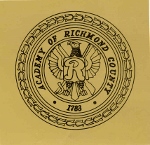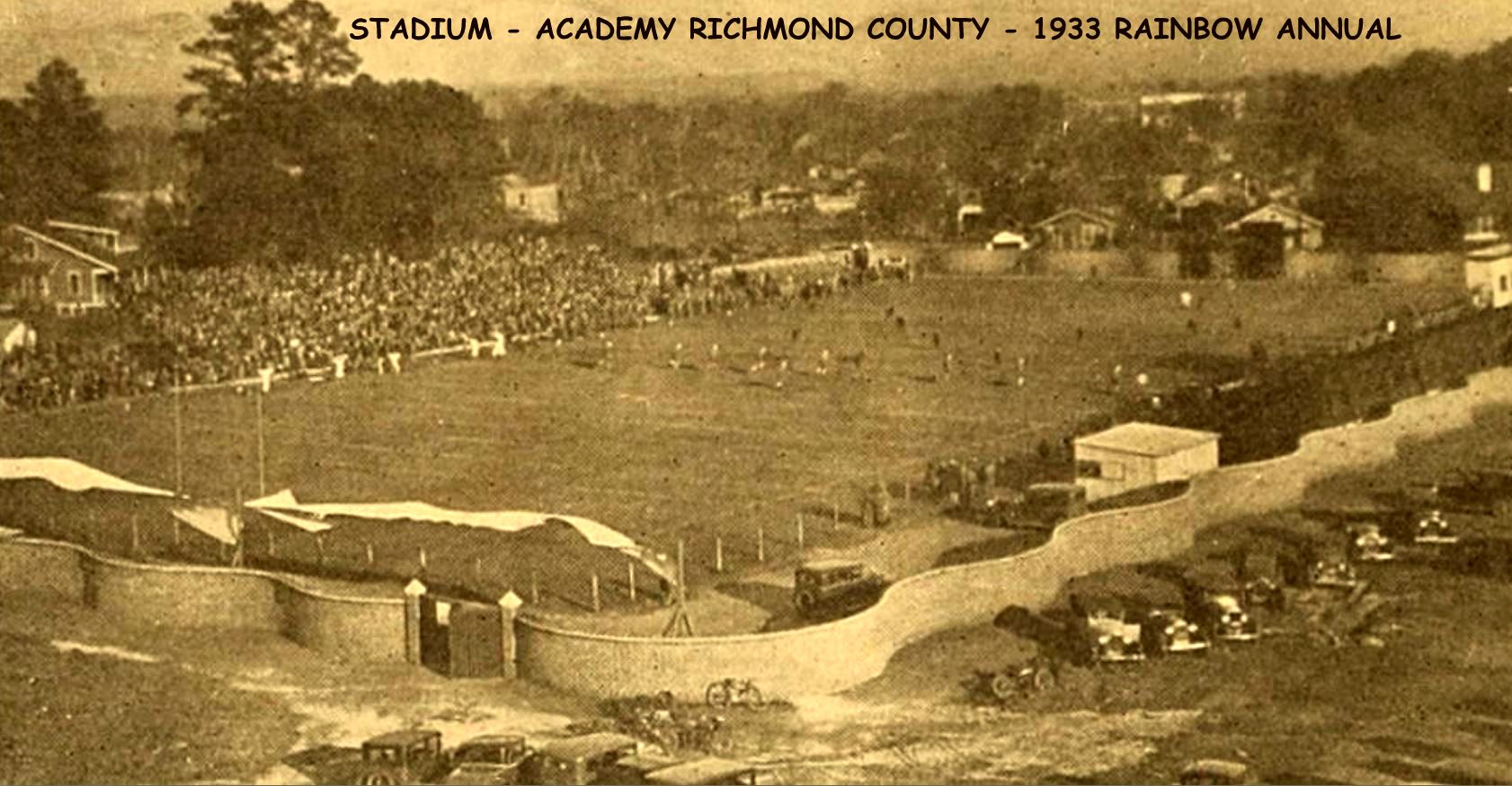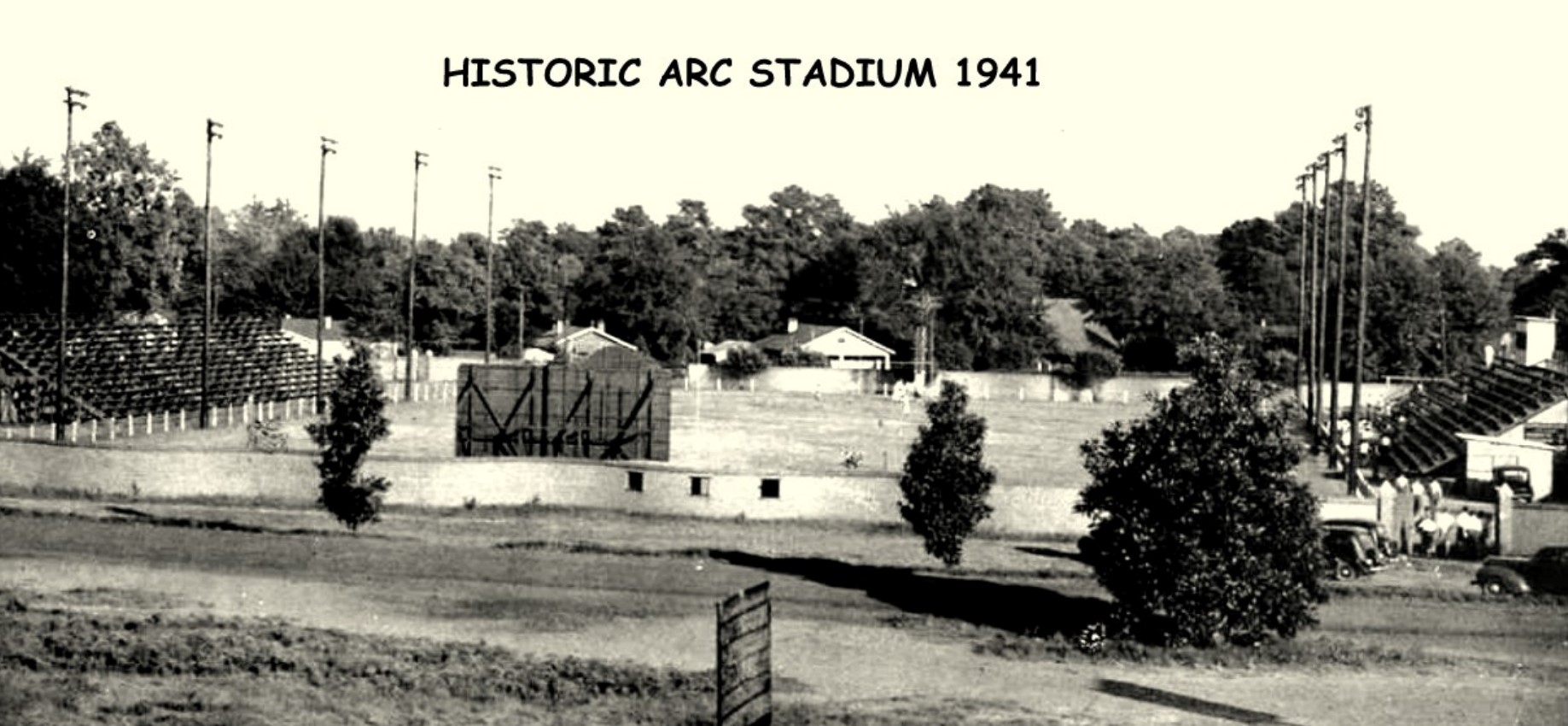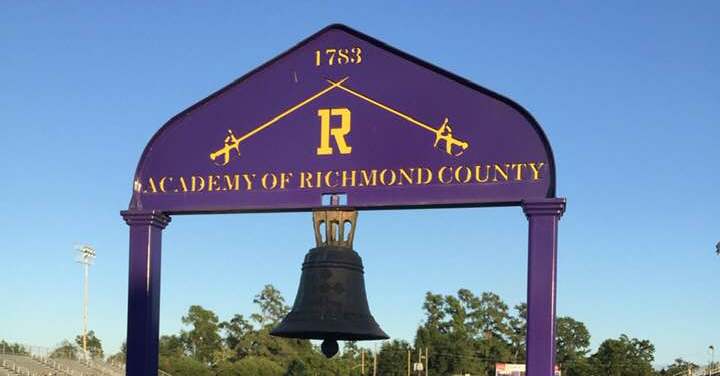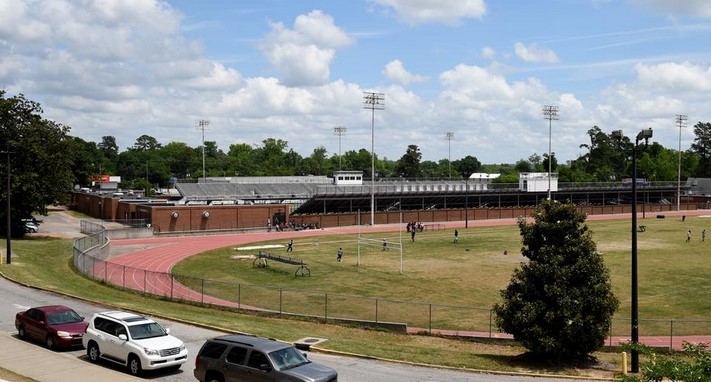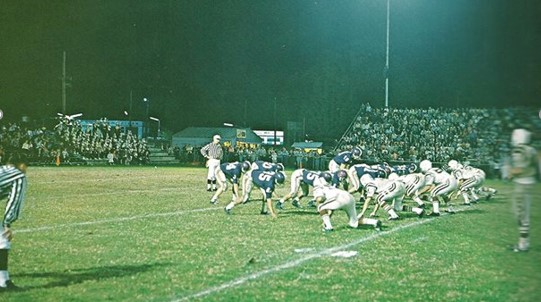many thanks to our loyal alumni for saving our stadium!!
Why Save the ARC Stadium?
Sometimes it takes a village. In this case it took some dedicated Alumni to compile this story. Truly a labor of love this compilation exemplifies their pride for a place of legendary history – our ARC Football Stadium. It has been the launch pad for decades of great folks and great deeds. Please take the time to thank the following:
Data Collection and Authors:
Jim Pardue, ’65
Jack Bearden, ’59
Editors:
Anne Murray Sims, ’69
Dr. Paulette Proctor Harris, ’67
Tison Smith King, ’67
Save the ARC Stadium – Our Historical Rallying Point
Over the decades, Augusta has lost many important buildings through floods, fires, and other disasters, but the most tragic–and senseless–losses have come through a failure to value and preserve the structures that help to tell the story of our city and its people. The history of our ARC Stadium is interwoven with over nine decades of Augusta’s history. Throughout the Great Depression, WWII, the Civil Rights struggles, or whenever Augustans needed a diversion, there was the ARC Football Stadium as our rallying point!
Save our Stadium and its History
Construction of the ARC Stadium was completed in 1930–just four years after the main school building opened in 1926, and only one year after the University of Georgia’s Sanford Stadium was built. Just weeks, ago UGA celebrated the 90th anniversary of its Sanford Stadium and named the playing field for legendary coach Vince Dooley. It is inconceivable that anyone would consider demolishing Sanford to build a parking lot! Our ARC Stadium is no less precious. It would be a travesty to do so.
Longtime Host of Youth Football in Augusta
For decades, our ARC Stadium was the only football stadium in the area and served as home field, not only for ARC, but for every other junior and senior high school in Richmond County. Literally, thousands of area youth have played football at our ARC Stadium. In the early 1930s, even Augusta Junior College, which has evolved into Augusta University, fielded a team that played at the ARC Stadium. For many years, ARC played a Thanksgiving Day game and hosted teams from as far away as Pennsylvania and West Virginia.
Our Stadium's Most Notable Game
ARC Stadium was the site of what may be the most notable football game ever played in Augusta–the Georgia Bulldogs versus the Daniel Field Flyers in 1943, just one year after UGA had captured the national championship by defeating UCLA in the Rose Bowl. The Flyers, who came from the Army Air Corps Training Center and included former college and professional players, defeated UGA’s players who were too young for military service.
Teams from Across our Nation
For two years–1964 & 1965, the stadium drew teams from every region of the United States as it hosted the National Championship Game for NAIA, the National Association of Intercollegiate Athletics, a conference comprised of more than 250 small colleges and universities. ARC Stadium was the venue for the 1966 GIA State Championship, won in front of a capacity crowd, by Augusta’s Laney High School!
A Heart for the Future
In 1967, the first integrated football game in the entire Central Savannah River Area and one of the first in the state of Georgia was played at the ARC Stadium. Augustans found common ground in sports, and ARC Stadium was at the heart of this process.
The Birth Place of Leaders
A number of ARC football players went on to achieve personal and professional
in Georgia and on the national stage, including the following:
Jimmie Dyess
Marine Lt. Colonel Jimmie Dyess is the only American to have been awarded both the Carnegie Medal for civilian heroism in saving two swimmers while he was a young Eagle Scout and the Medal of Honor for “conspicuous gallantry and intrepidity at the risk of his life” as the head of his troops in the Pacific during World War II. He was also the recipient of many posthumous honors: the destroyer USS Dyess was named in his honor in 1945; the Augusta Naval and Marine Corps Reserve Center was dedicated to Dyess in 1998; Georgia State Route 383 that runs from I-20 to Fort Gordon is named Jimmie Dyess Parkway in his honor; the Young Marines in Augusta chose Jimmie Dyess Young Marines as the official name of their organization, and every three years the Georgia-Carolina Council of the Boy Scouts of America celebrates his life during the Jimmie Dyess Days’ event at Fort Gordon. He was chosen as a 2012-2013 recipient of the ARC Hall of Fame.
Peter Pund
After graduation, Peter Pund played football for Georgia Tech, where, as team captain, he led the school to the 1928 National Championship against Notre Dame. Legendary ND Coach Knute Rockne said of him, “I sat at Grant Field and saw a magnificent Notre Dame team suddenly recoil before the furious pounding of one man–Pund, center. Nobody could stop him. I counted 20 scoring plays that this man ruined.” He was named Consensus All-American and was one of the first All-American players from the South. He was elected to the Georgia Tech Hall of Fame, the Georgia Sports Hall of Fame and the College Hall of Fame. He was chosen as one of the 2019-2020 recipient of the ARC Hall of Fame.
Carl Sanders
Carl Sanders played at Richmond before attending the University of Georgia on a football scholarship. Following his WWII service as a B-17 Flying Fortressbomber pilot, he returned to UGA for his law degree. Sanders served in the Georgia House of Representatives and, after one term, was elected to the Georgia Senate, where he was elected president pro tempore of the chamber. In 1962, Sanders was elected Governor of Georgia and, at that time, became the nation’s youngest governor. While in office, he worked to improve education and the environment and led the transition toward racial desegregation in the state. He was chosen as one of the 2012-2013 recipients of the ARC Hall of Fame.
Richard Sheridan
Following his ARC graduation, Richard Sheridan received an appointment to West Point. He was an outstanding athlete and student and was named Corporal of Cadets, the highest honor possible for a second classman. Tragically, Sheridan died from injuries he sustained in a 1931 game against Yale. An editorial at the time called him “a star of the first magnitude on the West Point eleven.” The Corps of Cadets erected a memorial–made of Georgia marble–on the West Point campus near the bank of the Hudson River. Additionally, the Sheridan Memorial Saber is awarded annually to an outstanding student at Richmond Academy.
An Incubator for Professional Athletes
At least two dozen players from ARC or its opponents who played at the ARC stadium including the NFL At least three ARC alumni went on to coach NFL or college teams.
John Small
John Small (ARC, The Citadel) played for the Atlanta Falcons and Detroit Lions and was inducted into the South Carolina Athletic Hall of Fame. Later, he helped to create a Christian ministry program to help troubled youth in Augusta.
Fran Tarkenton
Fran Tarkenton (Athens High, UGA) played in the NFL for 18 seasons with the Minnesota Vikings and New York Giants. He was the 1975 NFL Most Valuable Player and NFL Offensive Player of the Year.
Craig Baynham
Craig Baynham (North Augusta High, GA Tech) played college football at Georgia Tech. He was drafted in the 12th round of the 1966 NFL Draft and then played for the Dallas Cowboys, Chicago Bears, and St. Louis Cardinals.
Charlie Waters
Charlie Waters (North Augusta High, Clemson) played 12 seasons with the Dallas Cowboys and never experienced a losing season. He played in five Super Bowls, winning two. He holds the NFL record for playoff interceptions and has the unique achievement of blocking four punts in two consecutive games.
Theron Sapp
Theron Sapp (Lanier, UGA) received the nickname “Drought-Breaker” in the 1957 Georgia-Georgia Tech game. Tech had won the previous eight annual games, the longest streak in the series. Sapp recovered a Tech fumble, carried the ball nine times in the ensuing possession, and scored the winning touchdown. Sapp’s jersey (#40) is one of only four ever retired by UGA. He went on to play for the Philadelphia Eagles and Pittsburgh Steelers.
Bill Fulcher
Bill Fulcher (ARC, GA Tech) lettered in football, baseball and track & field at ARC. Under Tech Coach Bobby Dodd, he helped the Yellow Jackets to victories at the Sugar Bowl in 1954 and 1956 and the 1955 Cotton Bowl. He played for the Washington Redskins for two years and later coached at Georgia Tech, Florida, and Tampa. As head coach at Tech, his team won the 1972 Liberty Bowl. Fulcher was elected to the Georgia Sports Hall of Fame in 2015. He was chosen as one of the 2014-2015 recipients of the ARC Hall of Fame.
Ken Whisenhunt
Ken Whisenhunt (ARC, GA Tech) played for the Atlanta Falcons, the Washington Redskins and New York Jets. After nine seasons in the NFL, he began a coaching career at Vanderbilt University and then returned to the NFL to coach the Baltimore Ravens, Cleveland Browns, New York Jets, Pittsburgh Steelers, and Arizona Cardinals. He guided his team to the Super Bowl for the first time in franchise history, San Diego Chargers, and Tennessee Titans. He was chosen as one of the 2017-2018 recipients of the ARC Hall of Fame.
Ed Nutting
Ed Nutting (Northside Atlanta, GA Tech) played for the Cleveland Browns and the Dallas Cowboys.
Jake Fromm
William Jacob “Jake” Fromm is an American football quarterback for the Buffalo Bills of the National Football League. He played college football at Georgia and was drafted by the Bills in the fifth round of the 2020 NFL Draft.
Pat Dye
As 1956 team captain, Pat Dye (ARC, UGA) led ARC to the 1956 State Championship and was named All-American and All-State. He was recruited by UGA and helped lead the team to four SEC Championships. Dye was a two-time All-American at Georgia, and, after graduation, played three years in the Canadian Football League. After a stint in the Army, Dye coached at Alabama, East Carolina, and Wyoming before being named head coach at Auburn, a program he built into a Southeastern Conference power, winning four SEC Championships and coaching Heisman Trophy winner Bo Jackson. A three-time SEC Coach of the Year, Dye was inducted into the College Football Hall of Fame and the National Football Hall of Fame. He served as Athletic Director at Auburn and, in 2005, the University’s honored him by naming the playing field Pat Dye Field at Jordan-Hare Stadium. He was chosen as one of the 2012-2013 recipients of the ARC Hall of Fame.
Arnold Harrison
Arnold Harrison (Josey, UGA) is a two-time Super Bowl champion with the Pittsburgh Steelers and later played for the Cleveland Browns.
The spirits of these, and so many other former players, live on in the ARC Stadium. The ARC Stadium is hallowed ground for countless Richmond County citizens who have watched from the stands and cheered their teams over many decades. For them, the stadium is a glorious reminder, not only of the famous players and milestone games, but of the best years of their own lives.
Just as adding the International Baccalaureate Program to Richmond Academy’s curriculum enhanced the school’s academic mission and reputation without damaging its traditional focus, updates and improvements can be made to the current stadium without erasing its rich athletic traditions. The renovations done to the Stadium over the past few years demonstrate that it’s possible to accommodate present and future needs without demolishing the historic stadium.
Our ARC Stadium is a sacred place, and a shrine to past generations that must be preserved.
Help Us Support ARC’s historical stadium!
